Desktop astrophysics could be the next event on the horizon thanks to the synthesis of a new form of matter known as a Bose-Einstein condensate.
In 1924, Indian physicist Satyendra Nath Bose came up with an idea about the behaviour of photons. He reckoned they might exist in different energy states and he used his idea to derive Planck’s Law of Radiation without resorting to classical physics. Einstein extended Bose’s work to atoms, particles of matter and predicted that if a gas were cooled enough the atoms would condense into their lowest possible energy state. This weird form of matter, the Bose-Einstein condensate, was first created in a laboratory in 1995 and earned Eric Cornell (of NIST), Carl Wieman (University of Colorado) and Wolfgang Ketterle (MIT) the 2001 Nobel Prize in Physics.
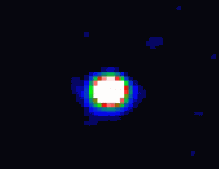
Burst movie
The quantum mechanical blob that is a BEC is not peculiar to the physics laboratory though. Astrophysicists believe that BECs could be at the core of one of the strangest entities in the universe – the neutron star. Ketterle cautions, however, that, while the two have some aspects in common, and it is nice to explore these analogies, I doubt that BEC work will contribute in a major way to advances in astrophysics.
Neutron stars are, as their name suggests, composed of neutrons and form under the enormous pressure as a star collapses. A thimbleful of neutron star would weigh a billion tonnes and the whole thing would sit neatly on Manhattan Island, New York. With a mass about 1.5 million times that of the sun, these iron-encrusted stars spin at hundreds of revolutions per second. The brittle, iron-rich crust of the neutron star hides an interior that is even more mysterious than their enormous density. Inside, they are fluid. In their swirling depths is a vast sea of neutrons – the debris from atoms crushed by a supernova explosion – and within those depths rage quantum storms.
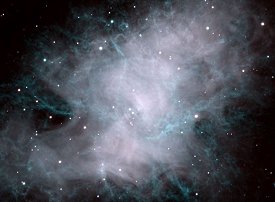
Crab Nebula
You might think such an object would be impossible to handle, but physicists would like to take a closer look at such stellar species as neutron stars and their cousins, the white dwarfs and black holes. They all represent extreme forms of matter that could betray the secrets of universe. The discovery of how to make a BEC in the laboratory provided a technical tip on handling the types of extreme matter that exist in a neutron star.
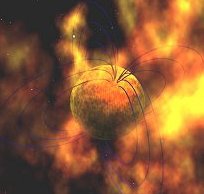
Magnetar
BECs are 100,000 times less dense than air, and are colder than interstellar space. In contrast, neutron stars have a density of up to 100 million tonnes per cubic centimetre, and their internal temperature is 100 times that of the centre of the sun. The link between the two, however, is in that they are both superfluids – they are liquids that flow with zero friction and zero viscosity.

Swiss cheese!
Setting a superfluid in motion is difficult. Try to rotate a container of supercold liquid helium-4, for instance, and the lack of friction between it and the inside wall of the container means it doesn’t budge. But, superfluids can swirl according to Ketterle. And the concept that unifies neutron stars and BECs is that they share this characteristic of superfluids. Ketterle and his colleagues at MIT began experimenting with swirling BECs. At the time, they did not have neutron stars in mind. BECs are a new form of matter, and we wanted to learn more about them, he explains, By rotating BECs, we force them to reveal their properties.
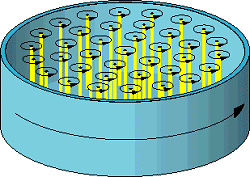
Quantum swirls
To set a BEC swirling Ketterle’s team shone a rotating laser beam on it while holding it in place with strong magnets. The experiment is like stroking a ping-pong ball with a feather until it starts spinning, muses Ketterle. The surprising thing was that suddenly, a regular array of whirlpools appeared in the BEC. It was a breathtaking experience when we saw those vortices, recalls Ketterle. Researchers had seen such whirlpools before (in liquid helium and in BECs) but never so many at once. This array of superfluid whirlpools was exactly the kind of storm system astronomers predicted would swirl beneath the iron crust of a neutron star.
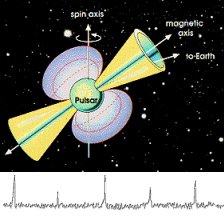
Lighthouse? Neutron star
Evidence for the swirling depths of neutrons stars is based on the fact that some neutron stars are pulsars – the emit a powerful beam of radiation as they spin – like a cosmic lighthouse. The pulses are very regular but occasionally there is a glitch and a pulse might come slightly too early or too late and it is these glitches that are thought to be due to superfluid vortices hammering into the inside of the neutron star’s crust.
Ketterle adds that attractions between atoms in a BEC could parallel the collapse of a neutron star so emulating the distant and massive in the laboratory too. The explosive collapse of a BEC, dubbed a Bosenova (pronounced bose-a-nova) by Wieman releases only a tiny quantity of energy, just enough to raise the temperature of the BEC by 200 billionths of a degree. Supernovae release many times the energy.
Further reading
Nature, 416, 211-218 (2002)
DOI: 10.1038/416211a
Satyendra Nath Bose
http://www.calcuttaweb.com/people/snbose.shtml
Wolfgang Ketterle
http://www.rle.mit.edu/rleonline/People/WolfgangKetterle.html
2001 Nobel Prize in Physics
http://nobelprize.org/nobel_prizes/physics/laureates/2001/
Neutron star
http://www.astro.umd.edu/~miller/nstar.html
Suggested searches
Neutron stars
Bose Einstein condensation
Superfluids